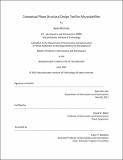| dc.contributor.advisor | David W. Miller. | en_US |
| dc.contributor.author | McLinko, Ryan (Ryan M.) | en_US |
| dc.contributor.other | Massachusetts Institute of Technology. Dept. of Aeronautics and Astronautics. | en_US |
| dc.date.accessioned | 2011-11-18T19:30:01Z | |
| dc.date.available | 2011-11-18T19:30:01Z | |
| dc.date.copyright | 2011 | en_US |
| dc.date.issued | 2011 | en_US |
| dc.identifier.uri | http://hdl.handle.net/1721.1/67068 | |
| dc.description | Thesis (S.M.)--Massachusetts Institute of Technology, Dept. of Aeronautics and Astronautics, 2011. | en_US |
| dc.description | This electronic version was submitted by the student author. The certified thesis is available in the Institute Archives and Special Collections. | en_US |
| dc.description | Cataloged from student submitted PDF version of thesis. | en_US |
| dc.description | Includes bibliographical references (p. 122-124). | en_US |
| dc.description.abstract | Gaining traction or momentum in the conceptual design phase for a complex system can be an arduous and daunting process, whether the complex system being designed is a satellite, airplane, car, or one of countless other systems. The design of small satellites is particularly affected by the difficulties in gaining traction since most of the customized tools that exist are proprietary, a significant experience base is required to be able to perform system level design trades, and the issue that most satellites serve one-of-a-kind applications. Of the subsystems in a satellite, the structures subsystem (along with other "downstream" subsystems, such as power and thermal), tends to be less mature during the conceptual design phase since its design depends strongly on the particular designs and requirements of each of the other subsystems, which also take time to mature. The Conceptual Phase Structural Design Tool for Microsatellites (SDT) facilitates the development of potential small satellite structural architectures and the selection of an initial satellite architecture to use in the detailed design process. The tool is capable of evaluating the strength, stiffness, mass, and inertial properties of a satellite architecture and is customizable to a wide range of potential missions by allowing for a number of structural architectures and customizable component placement. Furthermore, the tool has been developed with two key niches in mind. First, it is available to students with little to no satellite design experience, thus enabling a greater number of people, including those who are unfamiliar with the process of structural design at the beginning of the program, to design higher quality spacecraft from the start. Second, it is open source and deployable in a state that is usable and customizable by members of the satellite design industry. | en_US |
| dc.description.statementofresponsibility | by Ryan McLinko. | en_US |
| dc.format.extent | 124 p. | en_US |
| dc.language.iso | eng | en_US |
| dc.publisher | Massachusetts Institute of Technology | en_US |
| dc.rights | M.I.T. theses are protected by
copyright. They may be viewed from this source for any purpose, but
reproduction or distribution in any format is prohibited without written
permission. See provided URL for inquiries about permission. | en_US |
| dc.rights.uri | http://dspace.mit.edu/handle/1721.1/7582 | en_US |
| dc.subject | Aeronautics and Astronautics. | en_US |
| dc.title | Conceptual Phase Structural Design Tool for Microsatellites | en_US |
| dc.type | Thesis | en_US |
| dc.description.degree | S.M. | en_US |
| dc.contributor.department | Massachusetts Institute of Technology. Department of Aeronautics and Astronautics | |
| dc.identifier.oclc | 758652077 | en_US |
